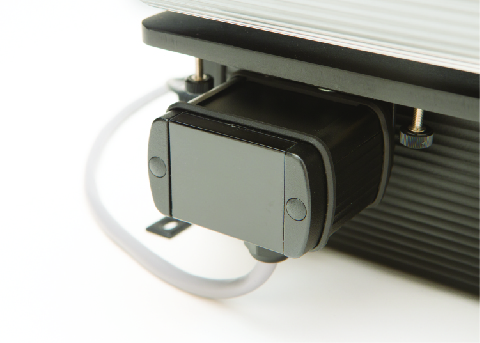Faster speeds and thinner materials… these are two of the most important trends the nonwoven industry is experiencing and equipment manufacturers are challenged to adapt to these trends rapidly. One of the innovative technological developments of 2015 addresses these two trends by providing a major leap in web guiding through the new sensor technology based on the principle of light scattering and a patented fiber optic sensing principle.

To the converter, faster speeds, thinner and lighter materials mean more production at less cost. However, these conditions can also mean a higher cost of downtime, as the number of units that could have been produced is higher, and of precision in material control of the web, as any deviation from the required accuracy will translate into more defective products.
Web guiding is one of these important, yet often overlooked, material control components. The trend for faster speeds and thinner material exposes the limitation of the current sensor technology in precisely detecting the true position of the web material.
At the end, what this translates to the converter in the nonwoven industry is operational problems such as glue on rollers, misplaced layers of material, material wrinkling or tears, and manual adjustments of the sensor due to changes in material thickness and density, product aesthetic problems such as misplaced resealable closures, and health issues such as glue or other materials that come into contact with the skin of the infant.
All in all, time, money, and products are wasted with inaccurate sensing technology. The new technology eliminates these problems for the nonwoven industry.
Today’s sensor technology is based on the principle of signal blocking. The blocking principle requires an emitter in one arm and a receiver in the opposite arm. The web runs between the arms and blocks an ultrasonic, pneumatic, or infrared signal. They provide a relative, inferred, analog measurement.
Sensor systems based on this principle depend on the assumption that the material is 100% impermeable to the emitted signal. However, materials are often not 100% impermeable, especially nonwovens, and this requires calibration of the sensor for each type of material. Furthermore, this type of technology can only infer or guess the position of the material. When the material characteristics change the sensor will perceive a change in signal but the position of the material is wrongly inferred. Every time the material characteristics change, the sensor has to be recalibrated to a new percentage of impermeability.
The new sensor technology with the light scattering and patented fiber optic sensing principle provides a true, absolute, precise, and digital position measurement of the web. The optical fiber optics act as filter that allows only the light signal that is in direct line with the fibers. A one dimensional pixel array collects and converts the light into digital voltage signal which is processed using an advanced digital signal processing algorithm.
Unlike the current sensor technology, the fiber optic sensors have the ability to detect the true edge of any type of material without the need for any manual adjustments of the sensor.
An interesting difference between the current technology sensors and the fiber optic sensor is that the latter is encased in one arm. This breaks away from the traditional design of U-shaped sensor that requires an arm for signal emission and an opposite arm for signal capture. Fiber optic sensors have the signal emission and reception in the same arm, allowing for a compact design that reduces damage from impacts in the production line.
Extensive testing has proven the capability of the sensor to be used with any material without calibration both in static and closed loop setup. Results confirmed the ability of the sensor to accurately detect the material, and in combination with the control algorithm of the guide, correctly position the material under various simulated disturbances.
Additionally, the true edge detection allows for higher precision and accuracy in web position correction. The new sensor technology allows for a true precision of 0.0635 mm, which the current technology cannot provide. Additionally, the sensor can be used for edge and center guiding, depending on the application required.
In general, fiber optic sensors offer the nonwoven sector an easier transition into higher speeds, handling thinner and lighter materials by providing a sensor that is more accurate and has the capability of handling different types of materials, or even materials that change characteristics within a roll during a production run. Moreover, this sensing technologies allow converters to reduce equipment inventory since one sensor can be used for multiple applications where a combination of ultrasonic, infrared and pneumatic sensors might be required.
However, there are other benefits that this technology opens. Higher precision opens opportunities for material savings as tolerances become tighter in order to run materials with narrower widths. In a future installment, we will discuss the latest developments in this technology. The fiber optic sensor is not only capable of edge and center detection, the same sensor can be used for line and contrast guiding which is very valuable for the label printing industry….
Want more information? Check out our product page, call us at +1 888-290-3215 or contact us.